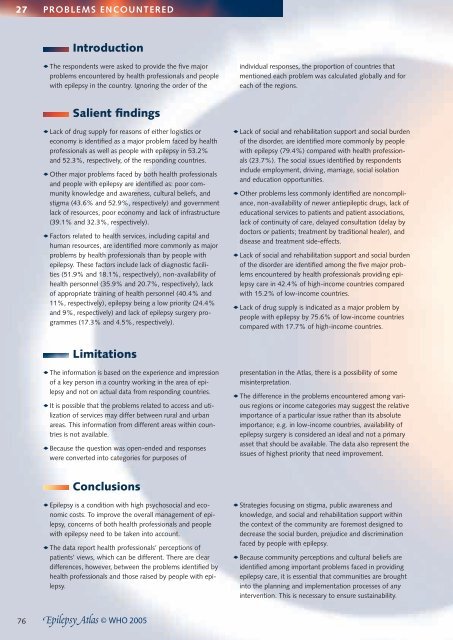Epilepsy - World Health Organization
Epilepsy - World Health Organization
Epilepsy - World Health Organization
Create successful ePaper yourself
Turn your PDF publications into a flip-book with our unique Google optimized e-Paper software.
27<br />
76<br />
PROBLEMS ENCOUNTERED<br />
Introduction<br />
◆ The respondents were asked to provide the five major<br />
problems encountered by health professionals and people<br />
with epilepsy in the country. Ignoring the order of the<br />
Salient findings<br />
◆ Lack of drug supply for reasons of either logistics or<br />
economy is identified as a major problem faced by health<br />
professionals as well as people with epilepsy in 53.2%<br />
and 52.3%, respectively, of the responding countries.<br />
◆ Other major problems faced by both health professionals<br />
and people with epilepsy are identified as: poor community<br />
knowledge and awareness, cultural beliefs, and<br />
stigma (43.6% and 52.9%, respectively) and government<br />
lack of resources, poor economy and lack of infrastructure<br />
(39.1% and 32.3%, respectively).<br />
◆ Factors related to health services, including capital and<br />
human resources, are identified more commonly as major<br />
problems by health professionals than by people with<br />
epilepsy. These factors include lack of diagnostic facilities<br />
(51.9% and 18.1%, respectively), non-availability of<br />
health personnel (35.9% and 20.7%, respectively), lack<br />
of appropriate training of health personnel (40.4% and<br />
11%, respectively), epilepsy being a low priority (24.4%<br />
and 9%, respectively) and lack of epilepsy surgery programmes<br />
(17.3% and 4.5%, respectively).<br />
Limitations<br />
◆ The information is based on the experience and impression<br />
of a key person in a country working in the area of epilepsy<br />
and not on actual data from responding countries.<br />
◆ It is possible that the problems related to access and utilization<br />
of services may differ between rural and urban<br />
areas. This information from different areas within countries<br />
is not available.<br />
◆ Because the question was open-ended and responses<br />
were converted into categories for purposes of<br />
Conclusions<br />
◆ <strong>Epilepsy</strong> is a condition with high psychosocial and economic<br />
costs. To improve the overall management of epilepsy,<br />
concerns of both health professionals and people<br />
with epilepsy need to be taken into account.<br />
◆ The data report health professionals’ perceptions of<br />
patients’ views, which can be different. There are clear<br />
differences, however, between the problems identified by<br />
health professionals and those raised by people with epilepsy.<br />
individual responses, the proportion of countries that<br />
mentioned each problem was calculated globally and for<br />
each of the regions.<br />
◆ Lack of social and rehabilitation support and social burden<br />
of the disorder, are identified more commonly by people<br />
with epilepsy (79.4%) compared with health professionals<br />
(23.7%). The social issues identified by respondents<br />
include employment, driving, marriage, social isolation<br />
and education opportunities.<br />
◆ Other problems less commonly identified are noncompliance,<br />
non-availability of newer antiepileptic drugs, lack of<br />
educational services to patients and patient associations,<br />
lack of continuity of care, delayed consultation (delay by<br />
doctors or patients; treatment by traditional healer), and<br />
disease and treatment side-effects.<br />
◆ Lack of social and rehabilitation support and social burden<br />
of the disorder are identified among the five major problems<br />
encountered by health professionals providing epilepsy<br />
care in 42.4% of high-income countries compared<br />
with 15.2% of low-income countries.<br />
◆ Lack of drug supply is indicated as a major problem by<br />
people with epilepsy by 75.6% of low-income countries<br />
compared with 17.7% of high-income countries.<br />
presentation in the Atlas, there is a possibility of some<br />
misinterpretation.<br />
◆ The difference in the problems encountered among various<br />
regions or income categories may suggest the relative<br />
importance of a particular issue rather than its absolute<br />
importance; e.g. in low-income countries, availability of<br />
epilepsy surgery is considered an ideal and not a primary<br />
asset that should be available. The data also represent the<br />
issues of highest priority that need improvement.<br />
◆ Strategies focusing on stigma, public awareness and<br />
knowledge, and social and rehabilitation support within<br />
the context of the community are foremost designed to<br />
decrease the social burden, prejudice and discrimination<br />
faced by people with epilepsy.<br />
◆ Because community perceptions and cultural beliefs are<br />
identified among important problems faced in providing<br />
epilepsy care, it is essential that communities are brought<br />
into the planning and implementation processes of any<br />
intervention. This is necessary to ensure sustainability.

















